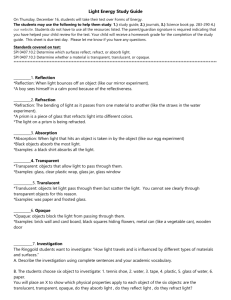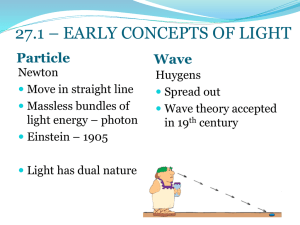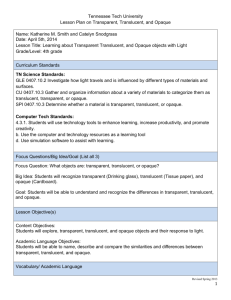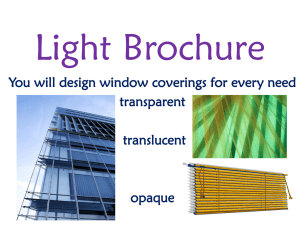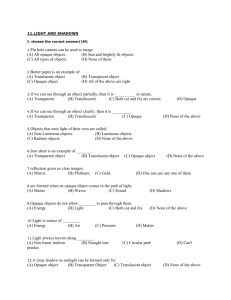Light Lesson #2: Transparent, Translucent, Opaque Time frame: 60
advertisement
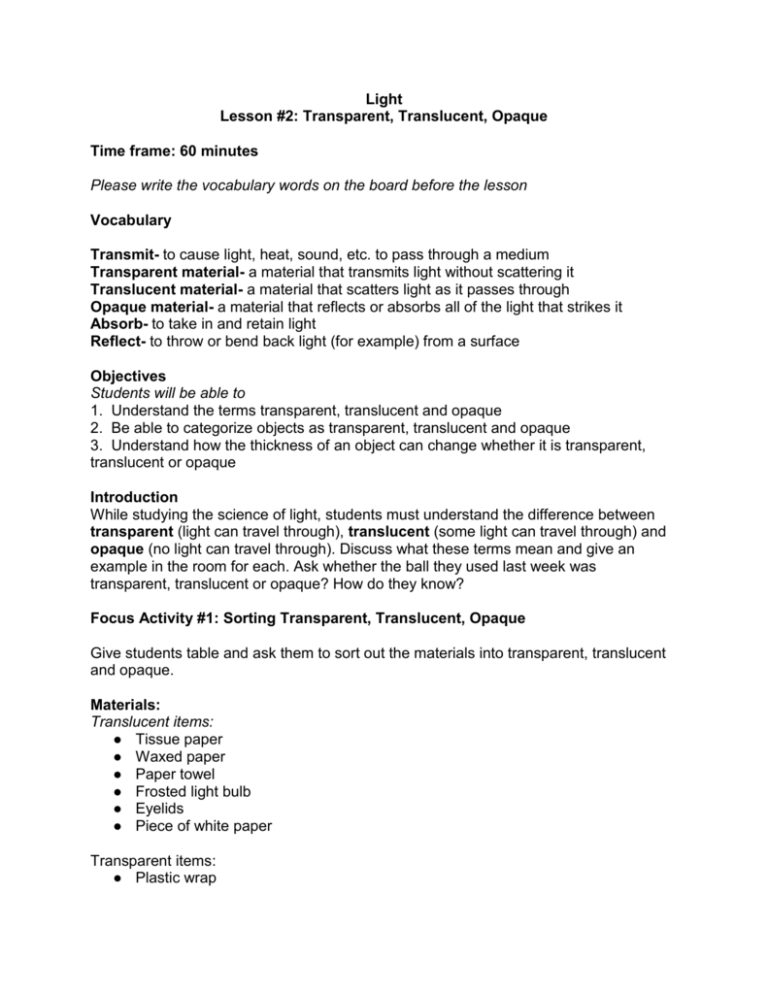
Light Lesson #2: Transparent, Translucent, Opaque Time frame: 60 minutes Please write the vocabulary words on the board before the lesson Vocabulary Transmit- to cause light, heat, sound, etc. to pass through a medium Transparent material- a material that transmits light without scattering it Translucent material- a material that scatters light as it passes through Opaque material- a material that reflects or absorbs all of the light that strikes it Absorb- to take in and retain light Reflect- to throw or bend back light (for example) from a surface Objectives Students will be able to 1. Understand the terms transparent, translucent and opaque 2. Be able to categorize objects as transparent, translucent and opaque 3. Understand how the thickness of an object can change whether it is transparent, translucent or opaque Introduction While studying the science of light, students must understand the difference between transparent (light can travel through), translucent (some light can travel through) and opaque (no light can travel through). Discuss what these terms mean and give an example in the room for each. Ask whether the ball they used last week was transparent, translucent or opaque? How do they know? Focus Activity #1: Sorting Transparent, Translucent, Opaque Give students table and ask them to sort out the materials into transparent, translucent and opaque. Materials: Translucent items: ● Tissue paper ● Waxed paper ● Paper towel ● Frosted light bulb ● Eyelids ● Piece of white paper Transparent items: ● Plastic wrap ● ● ● ● ● Clear glass Bubble wrap Laminating material Clear plastic lids Water Opaque: ● Construction paper ● Cardboard ● Felt ● Styrofoam ● Tin foil ● Wood ● Cloth ● Hand ● Stack of white paper After completing the sorting activity, ask if there are any "set" of rules that determine whether something is translucent, transparent or opaque. Plastic is an interesting material to discuss as the students discover that it can be all three. Absorption In which category was light absorbed the most? How do you know? Opaque objects absorb or reflect all of the light that strikes them. You can’t see through opaque materials because light cannot pass through them. Draw the following diagram on the board and follow the arrows. Explain how if all light either reflects off a surface or gets absorbed, then no light makes it through to the other side – this scenario would make an object opaque. But if some light is transmitted, then light does get through, which would make the substance translucent. If most of the light is transmitted and not absorbed or reflected, the substance is transparent. Pass out worksheet that shows how light absorbed and transmitted in opaque, transparent and translucent materials. Explain to students that colors absorb different amounts of light. EX: black absorbs more light than white does – that is why you get much hotter when you wear black on a summer day. Activity #2: Application to the Ocean Ask kids why one sheet of paper is translucent but a stack of papers is opaque. (Each sheet absorbs - soaks up - some light. When light has to pass through many sheets, all the light is absorbed.) Deep-sea divers know it is dark deep below the ocean’s surface. Just as a paper absorbs some light, so does water. As light passes through a lot of water, a little bit of light is absorbed at a time. After a while, very little light is left. In the ocean, sunlight passes only through the top layers of water. It is very dark deep in the ocean. For this reason, many kinds of sea creatures that live deep down in the ocean have to create their own light as opposed to depending on the light of the sun. This light that they make is called bioluminescent light. Read and explore about these fish using the iPad app Creatures of Light and going to The Deep Ocean. Conclusion/Assessment Go over vocabulary
